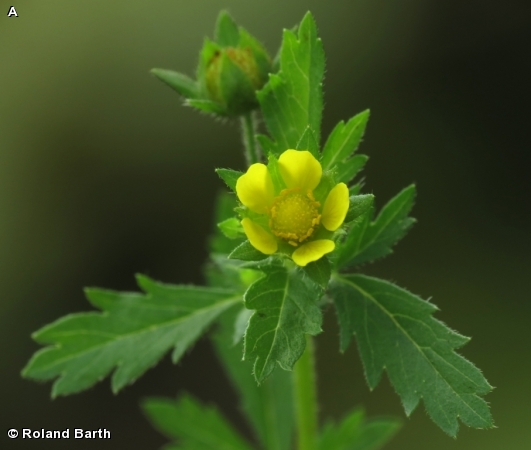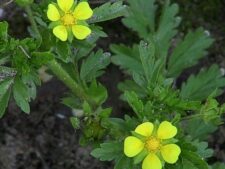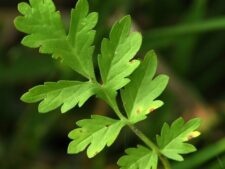
BUSHY CINQUEFOIL
Potentilla supina ssp paradoxa
ROSE FAMILY (Rosaceae)
 Identification
Identification
- Flowering time - May, June, July, August, September, October
- Uncommon on FF floodplain near river
- 5 petaled flower around a ring of yellow stamens and a dome-like center
- Lower leaves with 5-11 leaflets
- Larger number of lower leaflets separates it from similar Norwegian Cinquefoil (P norvegica) - see comments for details
This annual or short-lived perennial plant grows up to 2 feet tall. The freely branching lower leaves have 2-5 pairs of toothed leaflets and a variably lobed terminal leaflet (C). The upper leaves have three lobed, oval-shaped leaflets. Its yellow flowers are in clusters at the ends of the branches. Each flower has 5 petals backed by 5 lance-shaped sepals, their length equal to or slightly shorter than the petals. (A,B).
Grows along river banks, sandbars and other periodically flooded areas, flowering from May through October. In Fontenelle Forest, uncommon along the Missouri River. It has not been seen at Neale Woods to date.
Norwegian Cinquefoil (Potentilla norvegica) has similar bright yellow 5-petaled flowers, but the underlying pointed green sepals are longer than the petals. The best way to separate the two is to look at the leaves. Both species have compound leaves, but Norwegian Cinquefoil has leaves only in groups of 3. The present species, Bushy Cinquefoil, may have some upper leaves with 3 leaflets, but look closely at the lower leaves which will have up to 5 pairs of leaflets plus an odd terminal one (5-11 leaflets). Another Potentilla, India Strawberry (P. indica), is a low creeping plant with 3 broader, strawberry-like leaflets and conspicuous red fruits.
The potentillas are something of a moving target to taxonomists (the folks whose task it is to classify these similar, somewhat variable species). There has been discussion about the origin of our North American Bushy Cinquefoils, since they are so similar to the European species. For now the lumpers are prevailing and our Bushy Cinquefoil previously known as P. paradoxa has been changed to a subspecies of the European plant, P. supina. Hence the new name Potentilla supina ssp paradoxa. Fortunately, we have only the 2 species in the above paragraph to separate and it is relatively simple to do by counting the lower leaflets.
This plant was originally collected in Nebraska along the Platte River in 1820 by Edwin James of the Long Expedition.
The content of NatureSearch is provided by dedicated volunteer Naturalists of Fontenelle Forest who strive to provide the most accurate information available. Contributors of the images retain their copyrights. The point of contact for this page is: Roland Barth.


